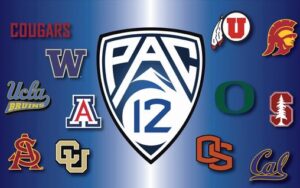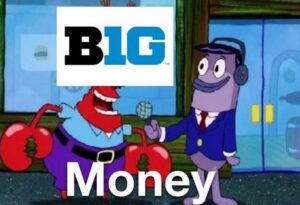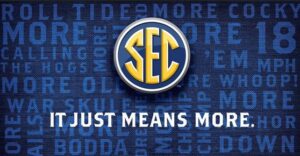Podcast: Play in new window | Download
Subscribe: RSS
Nearly every day seems to bring another set of rumors about the jumbled state of college athletics conferences.
Today’s hot story suggests that more impending doom is headed for the Pac-12 Conference.

The buzzards are circling once again as the athletic conference kingpin of the Pacific Coast fights to stay alive.
The University of Southern California (a 49,000 student private research university in Los Angeles) recently signed-up to move to the Big Ten Conference in 2024. So did their longtime crosstown public school rivals at UCLA.
With 47,000 students of its own, UCLA has become (pardon my pun) a political football.
Politicians are threatening to fumble the football for UCLA. After the school’s announcement to leave the Pac-12 and move to the Big Ten Conference in 2024, California’s governor (and presidential wannabe) Gavin Newsom is giving the media his version of Lee Corso’s famous line, “Not so fast!”

Ditto for the Board of Regents. The rhetoric (as usual in politics) sounds serious. One of those regents, John Perez, recently said, “All options are on the table.”
Yeah, right. Let me translate. “We want to make sure that the University of California in Berkeley (near San Francisco) receives an offer to move to the Big Ten, too!”
The Big Ten Conference is quickly becoming big, bad, and nationwide.

After a previous expansion gobbled-up East Coast schools like Rutgers (New Jersey) and the University of Maryland to go along with nearby Penn State, the Big Ten-tacles Conference surprised many sports fans recently by announcing that USC and UCLA would be coming aboard beginning in 2024.
The Pac-12 minus two equals just ten schools will be remaining. The earthquake is just beginning out west.
The University of Oregon has not been happy about being left out of the moving party. The Ducks have a legitimate right to gripe. Oregon has been the lone Pac-12 participant in the College Football Playoffs since the system started eight years ago in 2014.
By comparison, the SEC has placed ten teams into the four-team postseason field during the same period.
The Pac-12 Conference has been fading quickly from major sports relevance for more than a decade.

It’s not just in football, either. The last Pac-12 team to win the NCAA men’s basketball Final Four tournament was Arizona in 1997. That was 25 years ago.
Being in the Pac-12 Conference also means that your team is unlikely to be followed as much as teams positioned in the Eastern and Central time zones. With a 7PM Pacific Time kickoff for a college football game out west, it translates to a sleepy 10PM start on the East Coast. Only West Coast fans and East Coast football insomniacs, bettors, and college alumni are staying up to watch the late games after seeing three other football games preceding it every Saturday in the fall.
The truth is that the Pac-12 Conference has been less competitive in football than the SEC, Big Ten, Big 12, and ACC. The Pac-12 Conference television ratings are also the weakest of the bunch, too.
So, why would the Big Ten Conference throw a life preserver to USC, UCLA and, potentially, a few other Pac-12 schools?

Money, of course!
By snagging the #2 US television market in Los Angeles, the Big Ten Conference is planning to go shopping for other teams in large TV markets.
Let’s take a look around the Pac-12 and review the largest television markets for each school:
#2 – Los Angeles – USC and UCLA (got ‘em!)
#6 – San Francisco/Oakland/San Jose – both Cal (Berkeley) and Stanford (Palo Alto)
#11 – Phoenix – Arizona State University (Tempe)
#12 – Seattle/Tacoma – University of Washington
#16 – Denver – University of Colorado (Boulder)
#21 – Portland – Closer to Oregon State (Corvallis) than Oregon (Eugene)
#30 – Salt Lake City – University of Utah
#64 – Tucson – University of Arizona
#66 – Spokane – Washington State University (Pullman)
Based on the rankings of television market size, the Big Ten Conference is most likely to select just one of the San Francisco-area universities (Stanford or Cal). I could envision the Big Ten also selecting the University of Washington to wrap-up the #12 Seattle TV market with another pick.
As for #11 TV market Phoenix, Arizona State is located within the metro area while their intrastate rival (University of Arizona) is 110 miles to the southeast in #64 TV market Tucson. I think the Big Ten will take Arizona State and leave the U. of Arizona twisting in the wind.
That means, I believe the next four schools to be poached by the Big Ten will be:
- Stanford or the University of California – Berkeley (one but not both)
- University of Washington
- Arizona State
- Oregon
Though California governor Gavin Newsom and the state school system will lobby hard for the Big Ten to take Cal-Berkeley, the expanding Big Ten Conference should say, “No, thanks!”
If the Big Ten rejects Cal, it is possible that UCLA might have the rug pulled out from under them by the uppity California political class. Let’s hope not.
Since the Big Ten Conference is an athletics conference, let’s review some sobering sports facts about the lowly California Golden Bears.
This school has been a sports dud for decades. The last time Cal played in the Rose Bowl football game was 64 years ago in 1958! After legendary men’s basketball coach Pete Newell led the Cal men’s basketball program to the NCAA national championship game in both 1959 (a win) and 1960 (a loss), the hoops team has not returned to the Final Four since.
Cal is irrelevant in most major sports. If the Big Ten selects Cal, it’s purely for money.
The Oregon Ducks have built a national brand with their consistently good football program over the past two decades. The Big Ten Conference, though, can afford to be choosy. The Big Ten is likely running internal calculations based on the incremental national advertising dollars associated with each Pac-12 team’s “brand” over the incremental value associated with a school’s recent athletic accomplishments. Oregon is far from a slam dunk to enter the Big Ten.

America wants Oregon to be included in this party. I think they will make the cut, but barely.
So, what will happen to the remaining six teams which aren’t invited to join the Big Ten (Cal, Colorado, U. of Arizona, Oregon State, Utah, and Washington State)? Is the Big 12 Conference an option for some or all of them?
The Big 12 will be losing both the University of Texas and Oklahoma University to the SEC no later than 2025. It has already announced the addition of four teams in 2024 (University of Houston, BYU, Cincinnati, and Central Florida) to return the conference to 12 permanent members.
Just like the SEC and Big Ten have been doing, the Big 12 Conference is giving itself room to grow.
The Big 12 was the long-time former home of the University of Colorado. The Buffs could easily return to the Big 12 rather than being left stranded with the remnants of the Pac-12 Conference.
The Big 12 should be a good geographic fit for the University of Arizona in Tucson, too.
As for Utah, the Utes would be a big plus for the Big 12. There is one sticking point about Utah joining an expanded Big 12 Conference.
The Utes would be renewing their rivalry with Brigham Young.

These two teams don’t like each other. Their annual football game is called the “Holy War” as both schools usually have a majority of players who are Mormon. They have played football against each other nearly every season since 1896. Would Utah want to compete in the same athletic conference against BYU? That will be a tough decision.
I can see the Big 12 Conference adding no more than four teams from the rapidly dissipating Pac-12 soon. Let’s count Colorado and Arizona as “in”. I’ll put Utah down as “likely.”
Why wouldn’t the Big 12 Conference take all of the remaining Pac-12 teams?
The Big 12 would be wise to reserve a few slots in the event that a few desirable Atlantic Coast Conference teams (ACC) need a home soon. An expected hen house raid of the ACC by the Big Ten Conference and the SEC could materialize soon.
As stated in my story last month, the Big Ten Conference desperately wants to add Notre Dame (currently in the ACC for every sport except football). The Big Ten might reach out for to take the ACC’s Miami Hurricanes, too. That would add several large Florida markets into the prized TV portfolio of the expanding conference.
Meanwhile, the SEC may be setting its traps to secure North Carolina, Virginia Tech, Clemson, and, perhaps, Florida State from the ACC. All of those schools would make terrific regional additions to the SEC.

If the ACC fractures (as the Pac-12 seems to be doing right now), the Big 12 Conference would be smart to leave a few slots open to absorb a few of the stranded ACC member schools. Teams such as Pitt, Louisville, Georgia Tech, Virginia, and Wake Forest might need a home. They would be a much better geographic fit for an expanded Big 12 Conference than Oregon State, Washington State, and others from the Pac-12 Conference.
If the remaining Pac-12 schools eventually want a new conference home, the Mountain West Conference remains their best current bet. The Mountain West currently features eleven member schools and would roll out the red carpet for any former Pac-12 universities.
For many years, the college conference landscape has featured five major conferences (ACC, SEC, Big Ten, Big 12, and Pac-12). It is quickly narrowing to just two or three giant conferences. College athletics (for better or worse) are changing rapidly.

We will soon say “Farewell” to the Pac-12 Conference. It’s time to pack, man!

